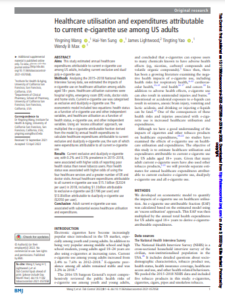
ABSTRACT
Aims This study estimated annual healthcare expenditures attributable to current e-cigarette use among US adults, including current exclusive and dual/poly e-cigarette use.
Methods
Analysing the 2015–2018 National Health Interview Survey data, we estimated the impacts of e-cigarette use on healthcare utilisation among adults aged 18+ years. Healthcare utilisation outcomes were hospital nights, emergency room (ER) visits, doctor visits and home visits. Current e-cigarette use was categorised as exclusive and dual/poly e-cigarette use. The econometric model included two quations: health status as a function of e-cigarette use and other independent variables, and healthcare utilisation as a function of health status, e-cigarette use, and other independent variables. Using an ’excess utilisation’ approach, we multiplied the e-cigarette-attributable fraction derived from the model by annual health expenditures to calculate healthcare expenditures attributable to current exclusive and dual/poly e-cigarette use, the sum of which were expenditures attributable to all current e-cigarette use.
Results
Current exclusive and dual/poly e-cigarette use, with 0.2% and 3.5% prevalence in 2015–2018, were associated with higher odds of reporting poor health status than never tobacco users. Poor health status was associated with higher odds of using the four healthcare services and a greater number of ER and doctor visits. Annual healthcare expenditures attributable to all current e-cigarette use was $15.1 billion ($2024 per user) in 2018, including $1.3 billion attributable to exclusive e-cigarette use ($1796 per user) and $13.8 billion attributable to dual/poly e-cigarette use ($2050 per user).
Conclusion
Adult current e-cigarette use was associated with substantial excess healthcare utilization and expenditures.
tobacco control
Yingning Wang, Hai-Yen Sung, James Lightwood,Tingting Yao and Wendy B Max

